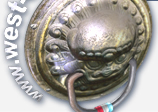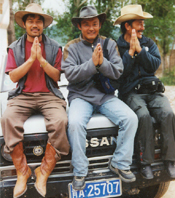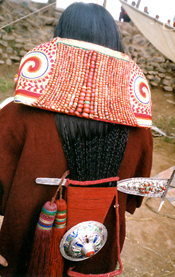

|
Landcruiser Adventure From Amdo to Kham In Eastern Tibet Changeable landscap along the uper reaches of Yellow, Yangtze and Mekong Rivers, Different Tibetan tribes, Nomadic people, Diferent sects of old monesteries. Day 1. Arrive at Chengdu or Beijing
Day 2. Fly to Xining Fly to Xining
and discover Xining. Day 3. Drive 310km via Guider to Tongder
County To enjoy changeable geographically landscape and to visit
a Nyinmapa monastery Terton Chogar built in 1831. The monastery
is famous for its 200 meters long Mani Wall and the religious opera
enacting the life of King Songtsen Gampo who first united whole
Tibet in 7th century. Government Guesthouse. Day 4. Drive 170km to Machen A hometown
of the Tibetan Golok people. If time allows we can visit two big
Gelukpa monasteries or can do some trekking on the way along the
Yellow River bank. Tsang-gar Gonpa is 30km away from the main road
in a beautiful valley, was built in 1765. Now it has 400 monks.
At the Yellow River bank, just by the road, we visit the Rabgya
monastery, is an important branch of Sera monastery in Lhasa, founded
at the advice of Dalai Lama 7 in 1769 by a Mongol from Kokonor named
Arik Geshe. Before 1958 the monastery had more than 1300 monks and
now has 500. Stay in Machen Snow Mountain hotel. Day 5. Machen To visit one or two old
monasteries and Golok nomad's family. Day 6. Drive 340km to Madoi If the
weather is fine we can see a good view of holy Anmye Machen snow
peaks on the way. Day 7. Drive 360km to Yushu(Tib: Jyekundo)
County Today's driving is exiting, we pass the first bridge of the
Yellow River, the famous mountain pass Bayankala at elevation 5080m
and upper reaches of the Yangtse River. Those landscapes present
you an amazing picture: Under the blue sky with white clouds, you
see different type of mountains decorated with pray flags, beautiful
grassland embellished with flock of yak and sheep, nomad's black
and white tents, the colorful dressed Golok and Khampa people while
some different sects of old monasteries on the way without tourists
to visit, which brings you back to the nature. Stay in Yushu hotel
with facilities in the rooms and hot water for shower. Day 8. Yushu (Jyekundo) The local people
honored Yushu as small Lhasa and more than 90% of people here is
Tibetan Khampa people, one of the four Tibetan main tribes. They
are strong and wild but honest and former fierce warriors of Tibet.
Many Sakyapa monasteries are concentrated here with different construction
style. We visit an important Sakyapa monastery Jyekundo Dondrublin,
built in 1398, which in old days had more than 1000 monks and created
many masters and scholars who made great acheavments to Tibetan
religion, medical, history and art. One of the Rinpoches Gyanak
created originally more than 100 kinds of dances and Jyekundo was
famous for the hometown of Tibetan dancing and singing. To visit
another old Sakya monastery Saiba Gonpa, was founded in 1269 and
30 km away from Jyekundo. Day 9. Drive 380km via Sershul Gonpa
to Zogqen (Tib: Dzogchen) monastery, one of four important Nyingmapa
Monasteries in Tibet, they are Katork, Paiyu, Mindroling. It was
built in 1684 on the advice of the Dalai Lama 5 and from its location
and background, you can imagine how great and holly it was during
past thousands of years. All foreigners who came here said they
were just in larger Switzerland, but altitude is 4023m. overnight
in the monastery. Day 10. Drive 160km to Dege About 52km
we pass a small town Manigango at the T-intersection, one road to
Garze and another to Derge. Most of the houses in Manigango are
made of timber and a small place where for truck drivers and nomads'
shopping, lunch and overnight. The famous holly and one of the most
beautiful Lakes Yilhun Lhatso is 15km from here on the way to Derge.
Starting from here we drive up to Tro La pass at 5080m and all the
way down to Derge is 90km. Derge Guest House. Day 11. Dege To visit Parkhang Printing
House, Gonchen Monastery and a very old Temple of Tangtong Gyelpo
was built in memory of Tibet's first multi-talented bridge-builder,
dramatist, engineer and treasure-finder during 11th century. Day 12. Drive 170km via Babang monastery
to Baiyu Along this road we pass Babang (Tib: Pelpung) monastery
30km away from the main road and Katork monastery 27km from the
main road, both located in beautiful valley. Babang was built in
1717 and is the most important learning centre for studying the
Kagyu tradition in East Tibet. Now it has more than 300 monks. After
visiting here we continue our trip to Baiyu County. Overnight in
Baiyu Hotel Day 13. Drive 50km to Gartok monastery
A really important and famous monastery at home and abroad, especially
for Nyingmapa believers as many famous scholars and masters graduated
from here for thousands of years. It was built in 1159. For Nyingmapa
monks, usually they study at home or mountain caves, only during
the religious activities and festival time, they gather in the monastery.
Day 14. To visit Baiyu ( Tib: Pelyul)
monastery in the county Day 15. Drive 245km to Garze or Kandze
Very nice driving, road is not so good but landscape is fantastic,
high mountains, rivers, forestry and the best grassland view. Garze
was once of the largest and important town in Kham area during the
17th century and Garze Gonpa is in town built in 1642 by Mongols.
It once was the largest monastery in Kham along side Chamdo with
1500 monks. But now almost everything in the temple looks new. We
must visit another old one Den Gonpa built in 13th century and was
luckily survived in the past political events. It is the most important
protector temple for the local people. Khampa Hotel. Day 16. Drive 160km to Dawu. Nothing
to see in the city. Just for overnight. Dawu hotel. Day 17. Drive 170km to Damba The place
where Tibetan Gyarong live. Gyarong is another tribe, which is different
from Golok and Khampa people. They speak their dialect and maintained
unique way of life and culture for centuries. The dress is also
distinctive. Most of the women wear multi-coloured embroidered headscarves
and elaborate belts and aprons. Almost every family has its own
block-house built with stones, ascending to heights of between 30-60
meters, which kept the powerful sino-Manchu armies at bay for 10
years during 18th century. Government GuestHouse. Day 18. Damba Go for trekking around
to the hill side to visit Gyarong family and to see their block
houses. Day 19. Drive 190km to Barkam. Mainly
enjoy the scenery along the road by the tributary of the Yangtze.
Nothing to see in Barkam city. Barkam Hotel. Day 20. Drive 250km to Aba ( Not open
yet for foreigners, but we will try to manage to get permit for
them if the situation would be all right at that time) is area where
nomadic groups and long established sedentary communities intermingle.
The villages are characterized by large detached adobe farming houses
with tapering walls and windows all on one side of the building.
Aba has also thrived on the trade for centuries; you can meet the
businessmen from here frequently throughout Tibetan area. The two
biggest Benpo monasteries of Narshi and Topgyel lie just here. Narshi
is large and was built in 1168, now it has 800 monks. The figures
and art works in the monasteries are quite different from other
sects, very impressive to see. Because of one of the important Tibetan
city in Amdo and the central of Tibetan culture, religion, trade
and communication, you will have a strong feeling of atmosphere
of real Tibetan culture and life here. The monasteries and a biggest
Tibetan style open market are highlight to be visited in Aba. Government
Guest House. Day 21. Aba visit Day 22. Drive 220km to Heishui ( Not
open yet). Less people have been to this sacred place even for us.
It is said it's interesting to see some old cultures about Gyarong
and Qiang people in this mystery county. Government Guest House
Day 23. Drive 230km to Songpan Day 24. Drive 90km to Juizhaigo. Juizhaigou
Bing Guang Day 25. Juizhaigou Day 26. Drive 430km to Chengdu Day 27. Exit
|




hqmails@yahoo.com
hqmails@aliyun.com
| (C)2007-2010 west-eastours.com. All Right Reserved. Designed by Jiyelan(JYL) Media. |